
The first Anglo-Sikh war was fought between the Sikh Empire and the British East India Company in 1845 and 1846 around the Ferozepur district of Punjab. It resulted in defeat and partial subjugation of the Sikh empire and cession of Jammu & Kashmir as a separate princely state under British suzerainty.
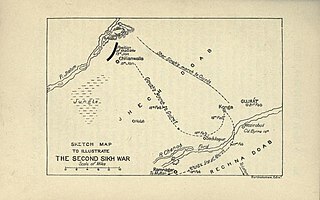
The second Anglo-Sikh war was a military conflict between the Sikh Empire and the East India Company which took place from 1848 to 1849. It resulted in the fall of the Sikh Empire, and the annexation of the Punjab and what subsequently became the North-West Frontier Province, by the East India Company.

Field Marshal Sir Patrick Grant, was a senior Indian Army officer. He fought at the Battle of Maharajpore during the Gwalior campaign, at the Battle of Mudki, the Battle of Ferozeshah and the Battle of Sobraon during the First Anglo-Sikh War and at the Battle of Chillianwala and the Battle of Gujrat during the Second Anglo-Sikh War. During the Indian Mutiny, as acting Commander-in-Chief, India, he directed the operations against the mutineers, sending forces under Henry Havelock and James Outram for the relief of Cawnpore and Lucknow. He later became Governor of Malta.

The Battle of Chillianwala was fought in January 1849 during the Second Anglo-Sikh War in the Chillianwala region of Punjab, now part of modern-day Pakistan. The battle was one of the bloodiest fought by the British East India Company. Both armies held their positions at the end of the battle and both sides claimed victory. The battle was a strategic check to immediate British ambitions in India and a shock to British military prestige.

The Battle of Sobraon was fought on 10 February 1846, between the forces of the East India Company and the Sikh Khalsa Army, the army of the Sikh Empire of the Punjab. The Sikhs were completely defeated, making this the decisive battle of the First Anglo-Sikh War.

The Battle of Aliwal was fought on 28 January 1846 between the British and Sikh forces in northern India. The British were led by Sir Harry Smith, while the Sikhs were led by Ranjodh Singh Majithia. Britain's victory in the battle is sometimes regarded as the turning point in the First Anglo-Sikh War.
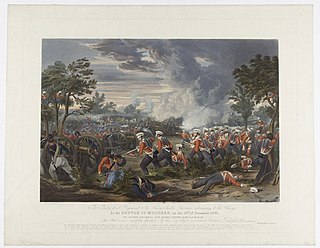
The Battle of Mudki was fought on 18 December 1845, between the forces of the East India Company and part of the Sikh Khalsa Army, the army of the Sikh Empire of the Punjab. The British army won an untidy encounter battle, sustaining heavy casualties.

The Battle of Ramnagar was fought on 22 November 1848 between British East India Company and Sikh Empire forces during the Second Anglo-Sikh War. The British were led by Sir Hugh Gough, while the Sikhs were led by Raja Sher Singh Attariwalla. The Sikhs repelled an attempted British surprise attack.

The Battle of Gujrat was a decisive battle in the Second Anglo-Sikh War, fought on 21 February 1849, between the forces of the East India Company, and a Sikh army in rebellion against the company's control of the Sikh Empire, represented by the child Maharaja Duleep Singh who was in British custody in Lahore. The Sikh army was defeated by the British regular and Bengal Army forces of the British East India Company. After it capitulated a few days later, the Punjab was annexed to the East India Company's territories and Duleep Singh was deposed.
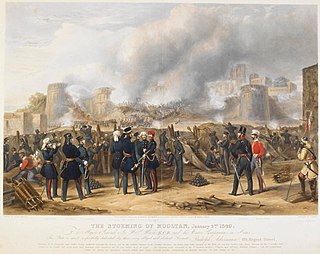
The siege of Multan began on 19 April 1848 and lasted until 22 January 1849, and saw fighting around Multan between the British East India Company and the Sikh Empire. It began with a rebellion against a ruler imposed by the East India Company, which precipitated the Second Anglo-Sikh War, and ended when the last defenders of the city surrendered to British forces.

Flashman and the Mountain of Light is a 1990 novel by George MacDonald Fraser. It is the ninth of the Flashman novels.

The Battle of Ghazni took place in the city of Ghazni in central Afghanistan on Tuesday, July 23, 1839, during the First Anglo-Afghan War.
The Treaty of Lahore of 9 March 1846 was a peace-treaty marking the end of the First Anglo-Sikh War. The treaty was concluded, for the British, by the Governor-General Sir Henry Hardinge and two officers of the East India Company and, for the Sikhs, by the seven-year-old Maharaja Duleep Singh and seven members of Hazara, the territory to the south of the river Sutlej and the forts and territory in the Jalandhar Doab between the rivers Sutlej and Beas. In addition, controls were placed on the size of the Lahore army and thirty-six field guns were confiscated. The control of the rivers Sutlej and Beas and part of the Indus passed to the British, with the Provision that this was not to interfere with the passage of passenger boats owned by the Lahore Government. Also, provision was made for the separate sale of all the hilly regions between River Beas and Indus, including Kashmir, by the East India Company at a later date to Gulab Singh, the Raja of Jammu.
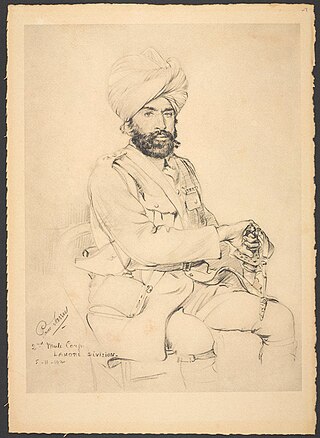
The 3rd (Lahore) Division was an infantry division of the Indian Army and before 1895, the Bengal Army, first organised in 1852. It saw service during World War I as part of the Indian Corps in France before being moved to the Middle East where it fought against troops of the Ottoman Empire.
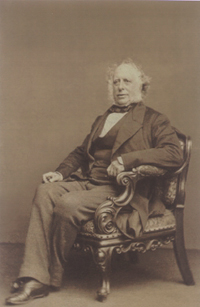
Sir Frederick Currie, 1st Baronet was a British diplomat, who had a career in the British East India Company and the Indian Civil Service. His posts included Foreign Secretary to the Government of India, Member of the Supreme Council of India, Resident at Lahore and Chairman of the East India Company.

Major George BroadfootCB was a Scottish army officer in the Madras Army of the East India Company.

Raja Lal Singh was Wazir of the Sikh Empire and commander of Sikh Khalsa Army forces during the First Anglo-Sikh War. Along with Tej Singh, Lal Singh was in the employ of the East India Company during the course of the war. Lal Singh was regularly supplying information and even receiving instructions from Company officers, communicating through Captain Peter Nicholson.

The Battle of Baddowal, known by locals as Angauli Jetu Jang, was an attack on 21 January 1846 by troops of the Sikh Empire on a contingent of the British East India Company near Ludhiana in the present-day state of Punjab, India. The battle ended with a Sikh victory.
Lieutenant-General Sir Michael White KCB was a British Army officer. The son of a major in the 27th Dragoons, he received a commission in the same regiment in 1804. White served in India on the Sikh frontier; during the 1817 Siege of Hathras; the 1817-18 Third Anglo-Maratha War and the 1825-26 Siege of Bharatpur. From 1839 he commanded the 3rd Light Dragoons and led them in the 1842 invasion of Afghanistan for which he was appointed a Companion of the Order of the Bath.
François Henri Mouton was a French Army officer. In his early career he served in the Garde du Corps and the Spahis, reaching the rank of captain before being placed on half-pay in 1838.






















